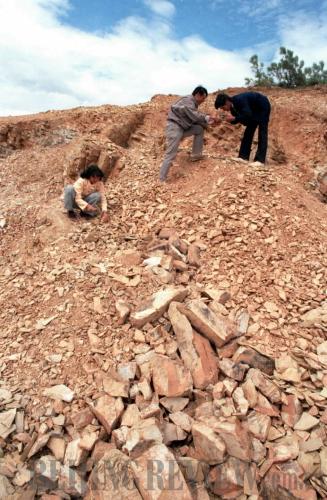|
 |
|
UNRAVELING THE MYSTERY: Paleontologists excavate fossils at Chengjiang's Cambrian fossil site on February 25, 2004 (XINHUA) |
The Cambrian Explosion, the rapid appearance of most major groups of complex animals around 530 million years ago, was a long-running puzzlement that Darwin tried to unravel with no success.
Before the Cambrian Explosion, life had existed on Earth for 4 billion years. However, during the first 3.5 billion years, organisms were simple, composed of only individual cells. About 530 million years ago, the major animal groups suddenly appeared. The Cambrian Explosion lasted around 2 million years, which, in relation to Earth's whole biological history, is the equivalent of 1 minute of one day.
The mysterious appearance of such a diverse array of sea born animals can only be described as an "explosion," as animals from tiny organisms of several millimeters to two-meter-long monsters with gigantic eyes and claws, covering almost all major animal phyla and sharing a similar body plan, began roaming the globe. This has left little doubt that almost all ancestors of existing animals, including humans, appeared during the eruptive evolutionary timeframe.
A large number of unearthed Cambrian fossils have contributed to clarifying details surrounding the Cambrian explosion. Of the more than 30 phyla covering all existing animals, Shu and his colleagues have found fossils of animals from more than 20 phyla at Chengjiang. Many forms seen in the fossil record had disappeared since then.
Paleontologists have excavated animal fossils at Chengjiang, an important Cambrian fossil site, for a century, making Chengjiang Biota one of the most remarkable fossil discoveries ever made. French scientists recorded Chengjiang's geological environment in detail as early as 1909. Large-scale searches for fossils started in the 1950s with a breakthrough made by Hou Xianguang, a paleontologist from Yunnan University.
On a rainy day in 1984, 35-year-old Hou continued his "boring work" of screening rocks for fossils with his assistant, a local villager he hired on the Maotian Mountain near Chengjiang. The daily routine had the villager mining rocks while Hou halved them, looking for fossils. At some point in the late afternoon, Hou came across the fossil of a soft-bodied animal about 5 cm long. The fossilized animal, with an exquisite degree of detail, had two shells and symmetrical legs.
"The excitement kept me awake for the whole night despite my exhaustion. I could not stop looking at the fossil," recalled Hou, whose lucky harvest eventually led to the discovery of a treasure trove of Cambrian fossils at Chengjiang.
During the next two decades, tens of thousands of fossil samples were unearthed in Chengjiang, belonging to 120 animal species. The rich deposits have made the county allegedly one of the most productive fossil collections in the world.
According to Darwin's theory of evolution, all forms of life developed from simple to complex organisms. However, the findings in Chengjiang might prove the existence of an opposite evolutionary route. Chen Junyuan, a paleontologist from the Nanjing Institute of Geology and Paleontology at the Chinese Academy of Sciences, said, "The evolutionary route was like a painter first drawing the sketches of a person and then perfecting the details."
Chen is also particularly intrigued by the fact that some organisms of Chengjiang fauna failed to change over the course of hundreds of millions of years. Chen hopes to conduct molecular biological studies on genes of some organisms to understand why they are resistant to changes.
| 